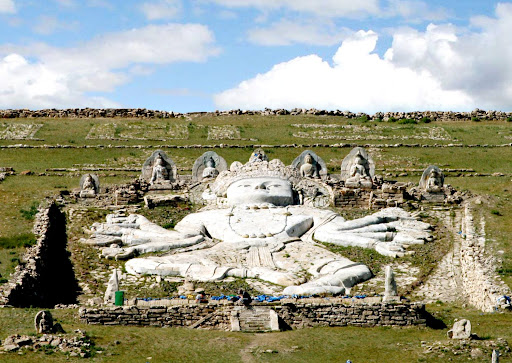“Ikh Burkhant Complex” Located 35 kilometers north of Sumber, the center of Khalkhgol soum in Dornod Province, on a bend along the western bank of the Khalkh River, lies the remarkable historical and cultural monument of Mongolia known as the “Ikh Burkhant” complex. This majestic site was built between 1859 and 1864 under the leadership of Togtokhtör, better known across Mongolia as “To Van” of the Ilden Jun Prince of the Setsen Khan Province. It is a testament to the ingenuity, craftsmanship, and collective labor of 18th-century Mongolian nomads, artisans, and smiths.

To construct the great Buddha, craftsmen combined crystal sand from Lake Buir, gravel from the Khalkh River, and white clay from Khamar Pass to form artificial stone. These materials, colored with natural ochre, created vivid and diverse hues. The ruins of the brickworks used in the project can still be found at Khuurt, near the Baruun and Zuun Khalkhait valleys of Khalkhgol soum, while the ceramics workshop was located southwest of Tsagaan Uul (White Mountain).
The creation of the Avalokiteshvara (Janraisig) Buddha was prompted by a series of devastating natural disasters—droughts and dzuds—that struck the Setsen Khan Province in the mid-19th century, severely reducing livestock and plunging the people into hardship. Though To Van consulted local nobility, no viable solution emerged. Seeking spiritual guidance, he turned to the lamas, who advised that commissioning a large image—or many images—of Avalokiteshvara would offer protection from calamity. Recognizing the wisdom in this and also the economic leakage of wealth from Mongolia to Tibet, China, and India via religious donations, To Van decided to retain religious merit and funds within the homeland. Avalokiteshvara, the deity of compassion and protector from danger, also symbolized national defense—representing a spiritual barrier against Chinese-Manchu influence on the eastern frontier.
After much deliberation, the nobility of the Setsen Khan Assembly resolved to construct the statue in the territory of To Van’s Ilden principality, recognizing its skilled labor force and construction experience. Originally, the plan called for a 12-cubit (approximately 5.5-meter) standing bronze statue, but To Van deemed this economically unfeasible and proposed instead a large reclining image sculpted from stone over a 2-hectare sloping terrain, incorporating multiple Buddhas and stupas.
Work began in the spring of 1859, with 40 workers preparing the foundation by leveling and digging to depths of 1–3 meters. Each stone used measured approximately 45–50 cm in length, 32–35 cm in width, and 20–25 cm in thickness. More than 180 artisans were employed throughout the project, each receiving a daily wage of one gold “tsen” coin. In total, it is said that the stones transported equaled the load of 1,000 ox carts.
Just as the project neared completion, a series of heavy summer rains in 1861 damaged the statue’s structure and foundation. Unable to continue on the same site, the project was relocated to a 35-degree slope along the Khalkh River’s western bank, where the statue was completed and consecrated in a grand ceremony in 1864.
In the 1970s, some local residents damaged the monument while removing stones for construction and burial purposes, severing the statue’s left leg. From 1994 to 1998, the Ikh Burkhant complex was restored through the joint efforts of Dornod province residents, Khalkhgol locals, the Institute of History and Philosophy at the Mongolian Academy of Sciences, and the To Van Research Society. A special 36-hour religious ceremony was conducted by G. Davaasambuu and his group of monks to reconsecrate the site, ensuring the monument’s preservation for future generations.
The statue of Avalokiteshvara lies at the center of a sloping area measuring 30 by 26 meters and rises to a height of 28.74 meters (over 80 cubits). It is surrounded by a double rectangular frame of stone, with the outer frame measuring 220 by 97 meters and the inner frame 113 by 63 meters. Between these frames, 20 Tibetan “lanza” script characters were inscribed horizontally. Additionally, 12 stone stupas measuring 200 by 110 cm were placed between the statue and the inner frame. Near the center, two circular stone ornaments, 5 meters in diameter, were embedded in bas-relief.
The statue of Avalokiteshvara features eight arms, each symbolizing one of the “Eight Great Perils.” The right hands depict a lion, elephant, serpent (symbolizing the naga), and a wrathful human figure. The left hands represent fire, water, a hook symbolizing the danger of alcohol, and a Garuda. The deity is shown with his right leg folded and left leg bent, draped in a ceremonial scarf and robes. A stone-carved lotus flower decorates the base of the statue, which connects to a 44 by 26 meter worship platform.
Flanking the statue are 66-cm wide stone steps that allow pilgrims to circumambulate clockwise without stepping on the sacred image. Around the central statue, over 20 images of Tara (the female Bodhisattva of compassion) were also sculpted.
In 1949, Soviet archaeologist A.P. Okladnikov, upon visiting the Khalkhgol valley, speculated that such a grand monument must have been built by a powerful ancient kingdom. However, this was later corrected by Mongolian scholar Kh. Perlee, who confirmed that the structure was the work of To Van in the mid-19th century.
One of the most fascinating mysteries of the complex is the technique used to create the surrounding statues. Though they appear as though molded from molten stone or metal, the exact methods remain unknown. Using black stone, the artisans carved intricate patterns that resemble inlaid silver—demonstrating extraordinary skill and artistic finesse.